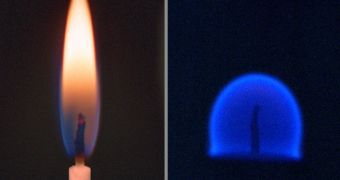Astronauts aboard the International Space Station (ISS) have recently conducted a series of experiments in orbit, meant to assess how to best fight fire both in space, and on Earth. In the future, these conclusions may be used to develop new tips and tricks for firefighters.
In space, the atmosphere and pressure inside spacecraft are not at all like those on Earth. There is also no up or down, no gravity either, so fire behaves unexpectedly. The entire Flame Extinguishment Experiment (FLEX) is set up to tease out the differences between how fire acts in space and on Earth.
One of the most important aspects is that fire can burn at much lower temperatures in space, at the same time requiring less oxygen to support the reaction. An implication of this is that flame extinguishers need to use concentrated material in order to deal with the flames.
On Earth, flames always go up, whereas in space, they tend to form a perfect sphere around a droplet of fuel, or another object that is set aflame. In fact, space fire takes on the rough outlines of whatever object is burning, Space reports.
According to University of California in San Diego (UCSD) aerospace engineering professor Forman Williams, the leader of the new investigation, the type of behavior flames display in space makes it very easy to observe how the fuel behaves and moves at it burns.
Though FLEX is being carried out aboard the ISS, the experiment is controlled by experts at the NASA John Glenn Research Center (JGRC) in Cleveland, Ohio. The fuel and ignition sources are located on the American-built Destiny module.
The experiment chamber can be used to simulate numerous atmospheric conditions, and it uses heptane or methanol as fuel. The Multiuser Droplet Combustion Apparatus (MDCA) is used to ignite the fuel.
FLEX was first conducted between March 2009 and December 2011, and a second instance just began last month. “Research leads to a better understanding of fire behavior. And better understanding ultimately leads to better safety design,” Williams explains.
“Findings could lead to new designs for cleaner fuels that have a smaller carbon footprint and emit fewer pollutants, among other applications,” a statement released by the UCSD goes on to say.

 14 DAY TRIAL //
14 DAY TRIAL //